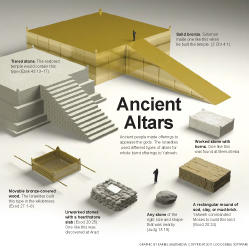13:1–18 Abram and Lot have returned to the Negev after leaving Egypt. Conflict over resources leads Abram to decide that he and Lot should go their separate ways. In the patriarchal narratives, separation is often used as a subtle indicator of rejection (21:14–21; 25:6). Lot’s separation from Abram excludes him from the promises intended for Abram’s offspring. Lot’s exclusion is also evident in his choice of where to settle: the cities of the plain in the Jordan Valley, which are outside the land promised to Abram. |
from Egypt Abram and Sarai had previously gone to Egypt to flee a severe famine in Canaan (see 12:10).
Lot went with him Abraham’s nephew. See 11:27.
13:2 very wealthy Abram was an international trader.
13:3 from the Negev Abram moves from southern and southeastern Judah around Beer-sheba.
13:4 he had made an altar See 12:8.
13:6 the land could not support them The large increase of livestock that Abram acquired in Egypt (12:16) may have made it difficult for Abram and Lot to dwell in close proximity. Competition for resources is a regular source of tension in the patriarchal narratives (compare 26:12–22; 36:6–7).
13:7 Canaanites Refers generically to a wide range of people groups.
Perizzites The Hebrew word used here, perizzi, is probably generic, like the Hebrew word for Canaanites. Perizzi refers to people who dwell in villages (compare Deut 3:5, where the related Hebrew word perazi means “unwalled village”); this distinguishes them from the city dwellers (the Canaanites). Elsewhere, the term perizzi occurs with names for distinct ethnic groups.
were living Indicates that the area and its resources were already in use by a settled population.
13:8 let there not be quarreling Abram defers to Lot rather than assert his seniority over him—a magnanimous gesture that shows good character.
13:10 like the garden of Yahweh Lot chooses the best part of the land.
in the direction of Zoar This apparently refers to the southernmost limit to the plain of Jordan (or the Jordan Valley); it was located on the southeast shore of the Dead Sea.
13:12 the land of Canaan The land along the eastern shore of the Mediterranean Sea all the way north to modern Lebanon and Syria, and inland to the boundary of the Jordan River.
Sodom The meaning of “Sodom” is unknown, as is its location. Gomorrah is likewise unknown and undiscovered.
is unknown, as is its location. Gomorrah is likewise unknown and undiscovered.
13:13 extremely wicked sinners against Yahweh This parenthetical note sets up the episode of Gen 19 and Sodom’s destruction by Yahweh. It also serves as a commentary on Lot’s character, contrasting it with Abram’s.
13:14–17 Yahweh rewards Abram for his decision, which firmly situates him in the promised land of Canaan. Here, Yahweh repeats to Abram the blessings of the covenant relationship (12:1–3). |
13:15 to your descendants See note on 12:7.
13:18 the oaks of Mamre The place where Yahweh appeared to Abram earlier in the narrative (see 12:6 and note).
Hebron Also called Kiriath-Arba (23:2), this area is where Abraham (Abram) will buy a cave to bury Sarah (Sarai; 23:17).
Hebron was located about 20 miles southwest of Jerusalem. Hebron factors in the biblical narratives from the patriarchal period and the monarchy. Abram was often in the region of Hebron, and many of the patriarchs and matriarchs were buried there, including Sarah, Abraham, Isaac, Rebekah, Leah, and Jacob. David was anointed king at Hebron (2 Sam 2:4), and the city was his capital for the first seven and a half years of his reign over Judah (2 Sam 5:4–5). Perhaps attempting to follow David’s example, Absalom declared himself king in Hebron, starting a revolt against his father David (2 Sam 15:7–12). |
he built an altar to Yahweh The altar and its sacred space are new and devoted entirely to Yahweh.
and its sacred space are new and devoted entirely to Yahweh.

|
About Faithlife Study BibleFaithlife Study Bible (FSB) is your guide to the ancient world of the Old and New Testaments, with study notes and articles that draw from a wide range of academic research. FSB helps you learn how to think about interpretation methods and issues so that you can gain a deeper understanding of the text. |
| Copyright |
Copyright 2012 Logos Bible Software. |
| Support Info | fsb |
 Loading…
Loading…




 Hebron
Hebron 